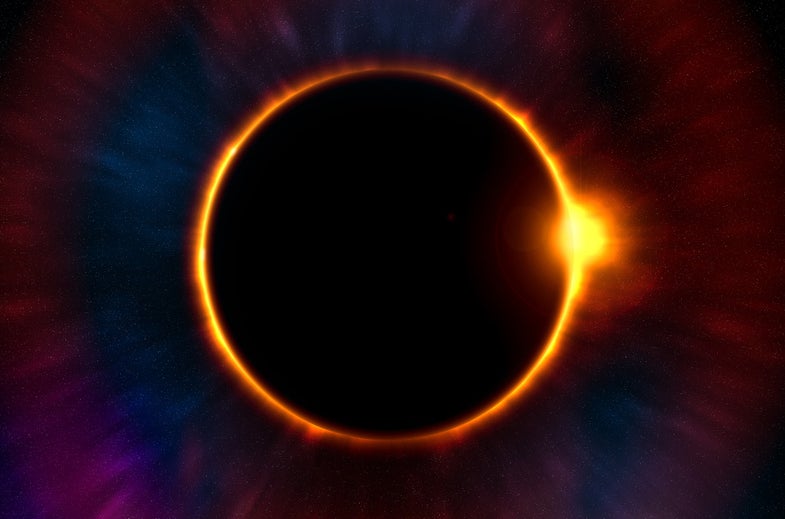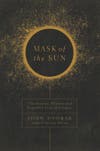The play-by-play of a total solar eclipse
Excerpt: Mask of the Sun

The following is an excerpt from Mask of the Sun: The Science, History and Forgotten Lore of Eclipses by John Dvorak.
There is much to see and very little time to do anything during a total solar eclipse. It begins when the Moon’s silhouette first touches the bright disk of the Sun, a moment that is known as first contact.
It takes more than an hour for the Moon to move across and completely obscure the Sun. During that hour or so, the part of the Sun that remains visible is the photosphere. It is the source of all visible light coming from the Sun. It is light from the photosphere that heats the Earth. It is also the part of the Sun that is usually considered as the “surface,” though there is no solid part of the Sun. Even the photosphere is a very tenuous gas, more than ten thousand times less dense than the Earth’s atmosphere at sea level. What appears to be a sharp edge to the Sun is an illusion caused by a rapid increase in the opacity of the gases of the photosphere, a change from almost clear to nearly opaque that occurs over a distance of a few miles. It should also be noted that it is within the photosphere that sunspots occur.

The amount of sunlight obviously decreases as the Moon continues to slide in front of the Sun, but because the human eye can adjust to the lesser light, the decrease is hard to notice until several minutes before totality. By then animals have started to respond. A gust of wind might be felt. Edmond Halley noticed such a wind in 1715 when a “Chill and Damp attended the Darkness” that caused “some sense of Horror” among the spectators. As the Sun disappears behind the Moon the ground begins to cool. That halts the rise of warm air from the ground, which causes a change in wind speed and a change in wind direction. There may also be a noticeable drop in air temperature that can be accompanied by the formation of fog. In contrast, there is no evidence that solar eclipses cause a change in cloud patterns, probably because the duration of an eclipse is too short to change the air temperature of the upper atmosphere.
As totality nears, things happen quickly, pulling one’s attention in different directions. The Moon’s shadow will soon pass over the ground, moving from west to east. The last rays of brilliant sunlight will soon shoot through valleys along the Moon’s rim and form Baily’s beads. The corona begins to appear, though at first very faint.
Then, at the moment of second contact, when brilliant sunlight is completely obscured, a bright red streak might be seen for a few seconds along that section of the Moon’s rim that has just extinguished the Sun. This streak is the chromosphere, which lies above the photosphere and which was first clearly described by George Airy in 1842 during a solar eclipse that he saw from Italy. He was looking at the eclipsed Sun through a telescope and saw what to him looked to be a range of bright red mountains. Today these “mountains” are known as spicules, and in appearance—in photographs much more detailed than Airy could have seen—have been likened to choppy sea waves or to a prairie fire burning through windblown grass. Actually, they consist of millions of gas jets. To put the chromosphere in perspective, the gases of this layer are about 5,000 degrees hotter and a million times less dense than the gases of the photosphere.
Around the rim of the eclipsed Sun may be one or more solar prominences. These are also masses of hot gases, rising higher than the chromosphere, which take the form of arches or irregular clouds that are suspended at these high levels by intense magnetic fields, such as those associated with sunspots.
And then there is, as Francis Baily remarked, the “bright glory” of the corona. Unlike the Earth’s magnetic field, the magnetic field of the Sun does not consist of a simple dipole. Instead, the Sun’s magnetic field is comprised of many pairs of regions of opposite magnetic polarity that are produced by the complex convective pattern within the Sun. The streaks and rays of the corona are the patterns of free electrons in the Sun’s atmosphere made visible because they scatter light that strikes them, like motes in a sunbeam. And because the concentrations of these free electrons are constrained by the contortions of the magnetic fields, the shape of the corona reflects that of the magnetic fields. For that reason, the corona has no permanent features. It is never still, but always in a state of continual change.
And, much too soon, the eclipse is over. The moment when sunlight returns, the Sun and the Moon are at third contact. Then, when the Moon finally moves completely off of the Sun, it is fourth contact.
The exact time when each of these four contacts will occur is what one finds listed when examining a modern eclipse prediction, a prediction that represents a culmination of intellectual curiosity and the accumulation of knowledge from around the world that took more than four millennia to produce. It is this understanding of the intricate workings of the universe that is one of the hallmarks of modern thought. It is the modern way that we link ourselves to the heavens.
Excerpted from Mask of the Sun: The Science, History and Forgotten Lore of Eclipses by John Dvorak, published by Pegasus Books. Reprinted with permission. All other rights reserved.
Popular Science is delighted to bring you selections from new and noteworthy science-related books. If you are an author or publisher and have a new and exciting book that you think would be a great fit for our website, please get in touch! Send an email to books@popsci.com.